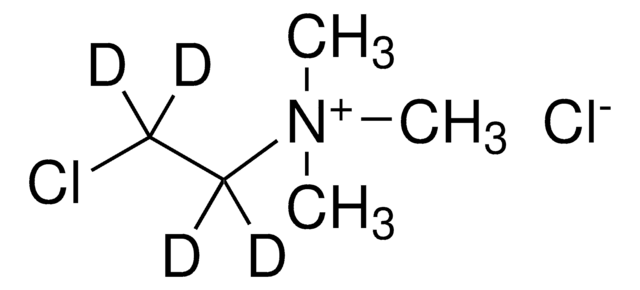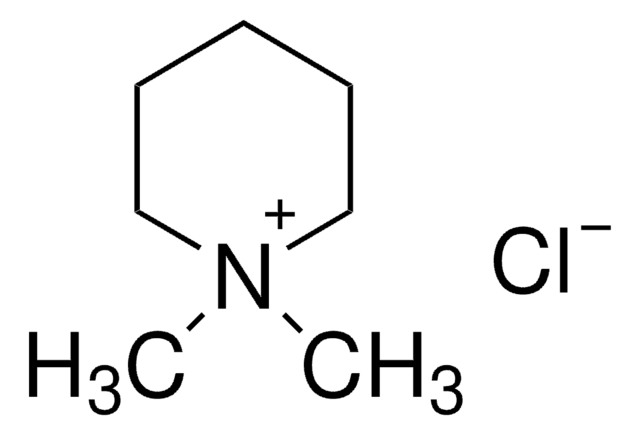93757
Chlormequat chloride
certified reference material, TraceCERT®, Manufactured by: Sigma-Aldrich Production GmbH, Switzerland
Sinonimo/i:
Chlorocholine chloride, (2-Chloroethyl)trimethylammonium chloride, Chlormequat chloride, Choline dichloride
About This Item
Prodotti consigliati
Grado
certified reference material
TraceCERT®
Livello qualitativo
Nome Commerciale
TraceCERT®
Durata
limited shelf life, expiry date on the label
Produttore/marchio commerciale
Manufactured by: Sigma-Aldrich Production GmbH, Switzerland
Stringa SMILE
[Cl-].C[N+](C)(C)CCCl
InChI
1S/C5H13ClN.ClH/c1-7(2,3)5-4-6;/h4-5H2,1-3H3;1H/q+1;/p-1
UHZZMRAGKVHANO-UHFFFAOYSA-M
Cerchi prodotti simili? Visita Guida al confronto tra prodotti
Categorie correlate
Descrizione generale
Certified content by quantitative NMR incl. uncertainty and expiry date are given on the certificate.
Download your certificate at: http://www.sigma-aldrich.com
Chlormequat chloride, also known as chlorocholine chloride (CCC) is the most widely used plant growth regulator that inhibits the biosynthesis of gibberellins. CCC is applied in agriculture and horticulture to promote sturdier growth by reducing the height of grain crops and increasing the diameter of the stems without causing a loss of plant productivity.
Chlormequat chloride has to be monitored in the Multiannual Control Programme for Pesticides Residues (MACP), run within the EU and EFTA in/on products of plant origin.
The European Communities (EC) have established maximum residue limits (MRLs) for CCC at 2 mg/kg for wheat, barley, and rye, 5 mg/kg for oat, and 0.05 mg/kg for other cereals. The agreed values of CCC as reported by EFSA are 0.04 mg/kg bw/day for the Acceptable Daily Intake (ADI), 0.04 mg/kg bw/day for the Acceptable Operator Exposure Level (AOEL), and 0.09 mg/kg bw/day for the Acute Reference Dose (ARfD).
According to Regulation (EU) No 540/2011, chlormequat is deemed to have been approved under Regulation (EC) No 1107/2009. This approval is restricted to its use as only a plant growth regulator.
Applicazioni
- Investigate the effect of drought on plant growth, essential oil concentration, oil biosynthesis, and peroxidase activity in the leaves of C. martinii and C. winterianus
- Study the effect of ethrel, chlormequat chloride, and paclobutrazol on growth and pyrethrins levels in Chrysanthemum cinerariaefolium Vis.
- Study the effect of chlormequat chloride (CCC) application at the bolting stage on the flowering, seed yield, and seed quality of lettuce plants previously treated with water or gibberellic acid (GA3)
- Investigate the effects of nitrogen rate, seed rate, and chlormequat chloride on the grain quality of oats (Avena sativa)
Prodotti consigliati
Note legali
Avvertenze
Danger
Indicazioni di pericolo
Consigli di prudenza
Classi di pericolo
Acute Tox. 3 Dermal - Acute Tox. 4 Oral
Codice della classe di stoccaggio
6.1C - Combustible acute toxic Cat.3 / toxic compounds or compounds which causing chronic effects
Classe di pericolosità dell'acqua (WGK)
WGK 2
Punto d’infiammabilità (°F)
Not applicable
Punto d’infiammabilità (°C)
Not applicable
Scegli una delle versioni più recenti:
Certificati d'analisi (COA)
Non trovi la versione di tuo interesse?
Se hai bisogno di una versione specifica, puoi cercare il certificato tramite il numero di lotto.
Possiedi già questo prodotto?
I documenti relativi ai prodotti acquistati recentemente sono disponibili nell’Archivio dei documenti.
Il team dei nostri ricercatori vanta grande esperienza in tutte le aree della ricerca quali Life Science, scienza dei materiali, sintesi chimica, cromatografia, discipline analitiche, ecc..
Contatta l'Assistenza Tecnica.






